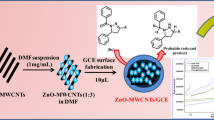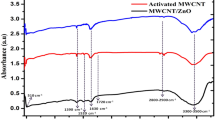Abstract
Multi-walled carbon nanotubes (MWCNTs) have structures characterized by remarkable mechanical and electronic properties. However, their applications can be hindered because of their hydrophobic nature, lack of homogeneity due to impurities, and their variable sizes. Thus, MWCNT was treated by acidic oxidation (H2SO4 3:1 HNO3), seeking out to evaluate the influence of this functionalization on the electrochemical reduction behavior of nitrofurazone applying cyclic voltammetry, the glassy carbon surface having been modified as working electrode. The MWCNT functionalization was characterized by using scanning electron microscopy, infrared and Raman spectroscopies, thermogravimetric analysis, and potentiometric titration. Differences between non-functionalized and functionalized MWCNT were observed, suggesting that carboxylic groups were introduced in the carbon nanotube walls. Moreover, the glassy carbon surface modification was also studied concerning the dispersing agents for functionalized MWCNT. Several solvents of different natures, hydrophilic and lipophilic, were evaluated. The best dispersion associated with electrochemical response of nitrofurazone was obtained with 1,3-dioxolane as dispersing agent, which presented higher affinity with MWCNT than the other solvents. The electrochemical response of the glassy carbon electrode modified with MWCNT was evaluated by nitrofurazone voltammetric behavior with emphasis on the \( \mathrm{R}-\mathrm{N}{\mathrm{O}}_2/\mathrm{R}-\mathrm{N}{\mathrm{O}}_2^{\cdotp -} \) couple generation and its kinetic stability.








Similar content being viewed by others
References
Zarbin AJG, Oliveira MM (2013) Nanoestruturas de carbono (nanotubos, grafeno): quo vadis? Quim Nova 36(10):1533–1539
Lin Z, Wu G, Ling Z, Lai KWC (2019) Carbon nanomaterial-based biosensors: a review of design and applications. IEEE Nanotecnol Mag 13(5):4–14
Yang C, Denno ME, Pyakurel P, Venton BJ (2015) Recent trends in carbon nanomaterial-based electrochemical sensors for biomolecules: a review. Anal Chim Acta 887:17–37
Belin T, Epron F (2005) Characterization methods of carbon nanotubes: a review. Mater Sci Eng B 119(2):105–118
Gupta N, Gupta SM, Sharma SK (2019) Carbon nanotubes: synthesis, properties and engineering applications. Carbon Lett 29(5):419–447
Sahihazar MM, Ahmadi TM, Nouri M, Rahmani M (2019) Quantum conductance investigation on carbon nanotube-based antibiotic sensor. J Solid State Electrochem 23(6):1641–1650
Rezaei B, Damiri S (2010) Development of a voltammetric procedure for assay of thebaine at a multi-walled carbon nanotubes electrode quantification and electrochemical studies. J Solid State Electrochem 14(6):1079–1088
Dogan-Topal B (2013) Electrooxidative behavior and determination of trifluoperazine at multiwalled carbon nanotube-modified glassy carbon electrode. J Solid State Electrochem 17(4):1059–1066
Bozal-Palabiyik B, Dogal-Topa B, Uslu B, Can A, Ozkan AS (2013) Sensitive voltammetric assay of etoposide using modified glassy carbono electrode with a dispersion of mult-walled carbon nanotube. J Solid State Electrochem 17(11):2815–2822
Ziyatdinova G, Gainetdinova A, Morozov M, Budnikov H, Grazhulene S, Red’kin A (2012) Voltammetric detection of synthetic water-soluble phenolic antioxidants using carbon nanotube based electrodes. J Solid State Electrochem 16(1):127–134
Montes RH, Dornellas RM, Silva AJ, Squissato L, Richter EM, Munoz RAA (2015) Amperometric determination of the insecticide fipronil using batch injection analysis: comparison between unmodified and carbon-nanotube modified electrodes. J Solid State Electrochem 20:2453–2459
Zhang W, Xu B, Hong YX, Yu YX, Ye JS, Zhang JO (2010) Electrochemical oxidation of salicylic acid at well-aligned multiwalled carbon nanotube electrode and its detection. J Solid State Electrochem 14(9):1713–1718
Fagan-Murphy A, Katarial S, Pateli BA (2016) Electrochemical performance of multi-walled carbon nanotube composite electrodes in enhanced with larger diameters and reduced specific surface. J Solid State Electrochem 20(3):785–792
Buang NA, Fadil F, Majid ZA, Shair S (2012) Characteristic of mild acid functionalized multiwalled carbon nanotubes towards high dispersion with low structural defects. Dig Nanomater Biosctruct 7(1):33–39
Chiang Y-C, Hian W-H, Chang Y-C (2011) The influence of treatment duration on multi-walled carbon nanotubes functionalized by H2SO4/HNO3 oxidation. Appl Surf Sci 257(6):2401–2410
Rahmam S, Mohammed NM, Sufian S (2014) Effect of acid treatment on the multiwalled carbon nanotubes. Mater Res Innov 18(6):196–199
Kim Y, Kwo S-M, Kim D-Y (2009) Dispersity and stability measurements of functionalized multiwalled carbon nanotubes in organic solvents. Curr Appl Phys 9(2):e100–e103
Moscoso R, Carbajo J, Squella JA (2014) 1,3-Dioxolane: a green solvent for the preparation of carbon nanotube-modified electrodes. Electrochem Commun 48:69–72
Kharissova OV, Kharisov BI, Ortiz EGC (2013) Dispersion of carbon nanotubes in water and non-aqueous solvents. RSC Adv 3(47):24812–24852
Dorim ACA, Aleixo H, Barcelos ED, Okumura LL (2015) Influence of the solvent on the “casting” methodology for MWCNT-modified glassy carbon and platinum electrodes. Electroanalysis 27(11):2663–2669
Panchakarla L, Govindaraj A (2008) Covalent and non-covalent functionalization and solubilization of double-walled carbon nanotubes in nonpolar and aqueous media. J Chem Sci 120(6):607–611
Ordeñana-Martínez AS, Rincón ME, Vargas M, Estrada-Vargas A, Casillas N, Bárcena-Soto M, Ramos E (2012) Carbon nanotubes/carbono xerogel-nafion electrodes: a comparative study of preparation methods. J Solid State Electrochem 16(12):3777–3782
Morita IM, Araújo GM, Codognoto L, Simões RF (2019) Functionalized multi-walled carbon nanotubes modified electrode for sensitive determination of Diuron in seawater samples. Int J Environ Anal Chem 99(15):1565–1574
Moscoso R, Carbajo J, Mozo JD, Squella JA (2016) Voltammetric behavior of 3,5-dinitrobenzoic acid in solution on GCE and encapsulated on multiwalled carbon nanotube modified electrode. J Electroanal Chem 765:149–154
Sierra-Rosales P, Toledo-Neira C, Squella JA (2017) Electrochemical determination of food colorants in soft drinks using MWCNT-modified GCEs. Sensors Actuators B 240:1257–1264
http://www.iq.usp.br/gutz/. Accessed August, 2019
Hu H, Bhomik P, Zhao B, Hamon MA, Itkis ME, Haddon RC (2001) Determination of the acidic sites of purified single-walled carbon nanotubes by acid-base titration. Chem Phys Lett 345(1-2):25–28
Brett AMO, Brett AM (1996) Electrochemistry. Principles, Methods and Applications. Oxford University Press, New York
Bard AJ, Faulkaner LF (2001) Electrochemical methods, fundamentals and applications, 2nd edn. Wiley, New York
Olmstead ML, Nicholson RS (1969) Cyclic voltammetry theory for disproportionation reaction and spherical diffusion. Anal Chem 41(6):862–864
Da Silva WM, Ribeiro H, Neves JC, Calado HDR, Silva GG (2014) Multi-walled carbon nanotubes functionalized with triethlenetetramine as fillers to enhance epoxy dimensional termal stability. J Therm Anal Calorim 115(2):1021–1027
Matthews MJ, Pimenta MA, Dresselhaus G, Dresslhaus MS, Endo M (1999) Origin of dispersive effects of the Raman D band in carbon materials. Phys Rev B 59:R6585-1–R6585-4
Goyanes S, Rubiolo GR, Salazar A, Jimeno A, Corcuera MA, Mondragon I (2007) Carboxylation treatment of multi-walled carbon nanotubes monitored by infrared and ultravioleta spectroscopies and scanning probe microscopy. Diam Relat Mater 16(2):412–417
Zhang J, Zou H, Qing Q, Yang Y, Li Q, Liu Z, Guo X, Du Z (2003) Effect of chemical oxidation on the structure of single-walled carbon nanotubes. J Phys Chem B 107(16):3712–3717
Silverstein RM, Webster FX, Kiemle D (2014) Spectrometric identification of organic compounds, 8th edn. Wiley, New York
Mesquita JP, Martelli PB, Gorgulho HF (2006) Characterization of copper adsorption on oxidized active carbon. J Braz Chem Soc 17(6):1133–1143
Alves LA, Castro AH, Mendonça FG, Mesquita JP (2016) Characterization of acid functional groups of carbon dots by nonlinear regression data fitting of potenciometric titration curves. Appl Surf Sci 370:486–495
Zhang Z, Pfefferle L, Haller GL (2015) Characterization of functional groups on oxidized multi-wall carbon nanotubes by potentiometric titration. Catal Today 249:23–29
Gooding JJ (2005) Nanostructuring electrodes with carbon nanotubes: a review on electrochemistry and applications for sensing. Electrochim Acta 50(15):3049–3060
Deng K, Liu X, Li C, Hou Z, Haowen H (2017) An electrochemical omeprazole sensor based on shortened multi-walled carbon nanotubes-Fe3O4 nanoparticles and poly (2, 6-pyridinedicarboxylic acid). Sensors Actuators B 253:1–9
Damasceno JPV, Zarbin AJG (2018) Electrostatic stabilization of multi-walled carbon nanotubes dispersed in nonaqueous media. J Colloid Interface Sci 529:187–196
Dresselhaus MS, Dresselhaus G, Jorio A (2008) Carbon nanotubes: advanced topics in the structure, properties and applications. Springer, Berlin
Hilding J, Grulke EA, Zhang ZG, Lockwood F (2003) Dispersion of carbon nanotubes in liquids. J Dispers Sci Technol 24(1):1–41
Yuan X, Zhang H, Chen Y (2011) Effect of ultrasonic disperse on the properties of carbon nanotube supercapacitors. Adv Mater Res 148-149:1417–1420
Zaragoza-Contreras EA, Lozano-Rodirgues ED, Román-Aguirre M, Antunes-Flores W, Hernández-Escobar CA, Flores-Gallardo SG, Aguilar-Elguezabal (2009) Evidence of multi-walled carbon nanotube fragmentation induced by sonication during nanotube encapsulation via bulk-suspension polymerization. Micron 40(5-6):621–627
González-Segura K, Cañate-Rosales, del Rio R, Yáñez C, Ferreyra NF, Rivas GA, Bollo S (2012) Effect of the dispersing agent on the electrochemical response of glassy carbon electrodes modified with dispersions of carbon nanotubes. Electroanalysis 24(12):2317–2323
Dalcanale F, Grossenbacher J, Blugan G, Gullo MR, Brugger J, Tevaearai H, Graule T, Kuebler J (2016) Rapid carbon nanotubes suspension in organic solvents using organosilicon polymers. J Colloid Interface Sci 470:123–131
Julião MSS, Almeida EC, La-Scalea M, Ferreira NG, Compton RG, Serrano SHP (2005) Voltammetric behaviour of nitrofurazone at highly boron doped diamond electrode. Electroanal 17(3):269–274
La-Scalea MA, Trossini GHG, Menezes CMS, Chung MC, Ferreira EI (2009) Electrochemical reduction using glassy carbon electrode in aqueous medium of a potential anti-Chagas drug: NFOH. J Electrochem Soc 156(7):F93–F97
Brito CL, Trossini GHG, Ferreira EI, La-Scalea M (2013) Nitrofurazone and its nitroheterocyclic analogues: a study of the electrochemical behavior in aqueous medium. J Braz Chem Soc 24(12):1964–1973
Squella JA, Bollo S, Nuñez-Vergara LJ (2005) Recent developments in the electrochemistry of some nitro compounds of biological significance. Curr Org Chem 9(6):565–581
Gosser DK Jr (1993) Cyclic Voltammetry: simulation and analysis of reaction mechanisms. VCH, New York
Masheter AT, Afiman P, Wildgoose GG, Wong E, Xiao L, Rees NV, Taylor R, Attard GA, Gary A, Baron R, Crossley A, Jones JH, Compton RG (2007) Investigating the reactive sites and the anomalously large changes in surface pKa values of chemically modified carbon nanotubes of different morphologies. J Mater Chem 17(25):2616–2626
Porto LS, Silva DN, de Oliveira AF, Pereira AC, Borges KB (2019) Carbon nanomaterials: synthesis and applications to development of electrochemical sensors in determination of drugs and compounds of clinical interest. Rev Anal Chem 38(3):20190017
Yin H, Zhou Y, HAN R, Qiu Y, Ai S, Zhu L (2012) Electrochemical oxidation behavior of 2,4-dinitrophenol at hydroxylapatire film-modified glassy carbon electrode and its determination in water samples. J Solid State Electrochem 16(1):75–82
Karuppiah C, Palanisamy S, Chen S-M, Emmanuel R, Ali MA, Muthukrishnan P, Prakash P, Al-Hemaid FMA (2014) Green biosynthesis of silver nanoparticles and nanomolar detection of p-nitrophenol. J Solid State Electrochem 18(7):1847–1854
Fedorczyk A, Ratajczak J, Kuzmych O, Skompska M (2015) Kinetic studies of catalytic reduction of 4nitrophenol with NaBH4 by means of Au nanoparticles dispersed in a conducting polymer matrix. J Solid State Electrochem 19(9):2849–2858
Yadav HM, Lee J-J (2019) One-pot synthesis of copper nanoparticles on glass application for non-enzymatic glucose detection and catalytic reduction of 4- nitrophenol. J Solid State Electrochem 23(2):503–602
Acknowledgments
The authors wish to thank CAPES, FAPESP, and CNPq research fellowship to E.I.F. and M.A.L. Thanks to Núcleo de Instrumentação para Pesquisa e Ensino (NIPE), UNIFESP, campus Diadema. Thanks to Silvia H.P. Serrano and Lúcio Agnes from Instituto de Química da Universidade de São Paulo (SP).
Author information
Authors and Affiliations
Corresponding author
Additional information
Publisher’s note
Springer Nature remains neutral with regard to jurisdictional claims in published maps and institutional affiliations.
Electronic supplementary material
ESM 1
(PDF 269 kb).
Rights and permissions
About this article
Cite this article
Brito, C.L., Ferreira, E.I. & La-Scalea, M.A. Multi-walled carbon nanotube functionalization and the dispersing agents study applied for the glassy carbon electrode modification and voltammetric reduction of nitrofurazone. J Solid State Electrochem 24, 1969–1980 (2020). https://doi.org/10.1007/s10008-020-04621-2
Received:
Revised:
Accepted:
Published:
Issue Date:
DOI: https://doi.org/10.1007/s10008-020-04621-2




